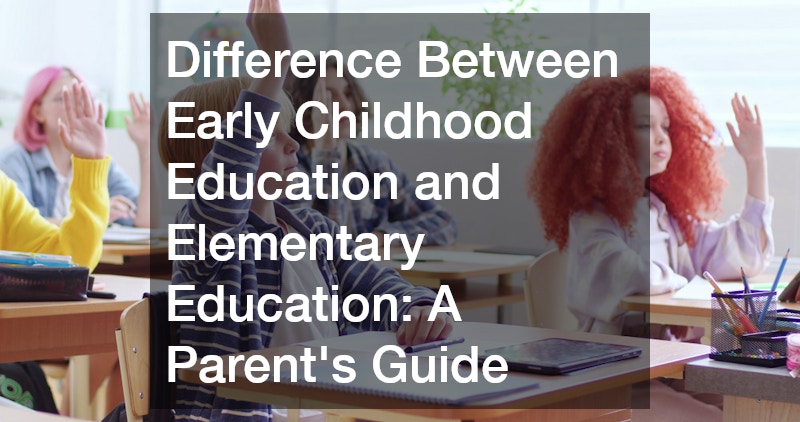
Choosing the right educational path for your child starts with understanding the key stages in their learning journey. Two of the most important and foundational stages are early childhood education and elementary education. While they may seem similar at first glance, these two stages are quite different in terms of goals, teaching styles, learning outcomes, and developmental focus.
For parents, knowing the distinctions can help in making informed decisions about preschools, kindergartens, and elementary schools. This guide will break down the differences, answer common questions, and highlight what you should consider when supporting your child’s early education.
What Is Early Childhood Education and Why Is It So Important?

Early childhood education (ECE) typically covers the age range from birth to around 5 or 6 years old, before a child enters formal grade school. This stage is widely regarded as one of the most critical periods for brain development, social-emotional learning, and foundational skill-building. During these early years, children absorb knowledge rapidly, making it the perfect time to nurture curiosity, communication skills, and emotional resilience.
ECE environments, such as preschools and daycare centers, focus on play-based learning, motor skills development, early literacy, and social interaction. Educators in this field aim to provide a warm, nurturing space where young children feel safe to explore and learn at their own pace.
Key Features of Early Childhood Education:
- Ages: 0 to 5 or 6 years old
- Learning Style: Play-based, sensory-rich, hands-on
- Focus Areas: Emotional development, language skills, basic motor coordination
- Teacher Role: Facilitator and caregiver
- Typical Settings: Preschools, daycare centers, early learning centers
How Does Elementary Education Differ from Early Learning?
Elementary education generally begins around age 6 and extends through age 11 or 12, covering grades 1 through 5 or 6, depending on the school system. While early childhood education emphasizes exploration and developmental play, elementary education introduces structured learning with clear academic objectives.
At this stage, children build upon the foundational skills learned in early childhood by diving into subjects like math, reading, science, and history. Teachers often follow a specific curriculum, and assessments become more frequent. Children begin to develop study habits, organizational skills, and critical thinking abilities.
Key Characteristics of Elementary Education:
- Ages: 6 to 12 years old
- Learning Style: Structured, curriculum-based
- Focus Areas: Academic knowledge, reading comprehension, math reasoning
- Teacher Role: Instructor and evaluator
- Typical Settings: Public and private elementary schools
Difference Between Early Childhood Education and Elementary Education: A Side-by-Side Comparison
To make it easier for parents to visualize the differences, here’s a quick breakdown:
| Feature | Early Childhood Education | Elementary Education |
| Age Range | 0–5 or 6 years | 6–12 years (Grades 1–5/6) |
| Learning Environment | Informal, play-based | Formal, subject-based |
| Teaching Approach | Exploration and discovery | Instruction and curriculum-driven |
| Focus Areas | Social skills, emotional growth | Reading, math, science, and structured topics |
| Assessment | Observation and developmental tracking | Graded assessments and performance |
| Role of Parent | High involvement in daily activities | Moderate involvement in homework, behavior |
Understanding these contrasts helps parents guide their children through a smooth and supportive transition from one stage to the next.
What Skills Do Children Learn at Each Stage?
Each educational stage is designed to build specific skills appropriate to the child’s developmental level. Let’s take a closer look:
In Early Childhood Education, Children Learn:
- Basic motor coordination and sensory skills
- Early communication and vocabulary
- Emotional regulation and empathy
- Social interaction through cooperative play
- Imagination and creativity
In Elementary Education, Children Develop:
- Reading fluency and writing skills
- Problem-solving and basic mathematics
- Critical thinking and memory recall
- Organization and responsibility
- Group collaboration and respect for rules
Both sets of skills are equally important. The first stage lays the emotional and cognitive foundation, while the next builds the structure for academic and lifelong success.
What Should Parents Consider When Choosing Between the Two?

Although the stages are sequential, choosing the right programs at each level can significantly impact your child’s growth. Here are a few questions to guide your decision-making process:
- Does the preschool or early childhood center have a clear educational philosophy?
- Are the teachers trained in child development and early learning strategies?
- Does the elementary school offer strong academic support and enrichment programs?
- How well does the school support transitions between preschool and grade school?
- Is your child emotionally and cognitively ready for more structured learning?
Your child’s personality, interests, and development pace should all play a role in selecting the right environment for both early and elementary education.
Final Thoughts: Supporting Your Child Through Both Educational Stages
While early childhood education and elementary education serve different purposes, they are both essential to your child’s lifelong learning journey. ECE nurtures the roots of curiosity, social connection, and emotional growth, while elementary education expands those roots into a framework of academic skills and structured knowledge.
As a parent, your understanding of these stages empowers you to ask better questions, choose more fitting programs, and provide more meaningful support at home. Keep communication open with educators, remain involved in your child’s development, and celebrate every milestone—big or small.
By acknowledging the difference between early childhood education and elementary education, you’ll be better equipped to guide your child through these formative years with confidence.

